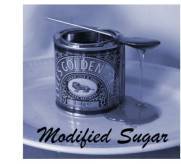Three types:
HFCS-42 is a form of high fructose corn syrup that contains 42% fructose. 10% sweeter than sugar. A typical breakdown would be:
Sugar Percentage Fructose 42% Glucose 53% Maltose 5%
HFCS-55 is a form of high fructose corn syrup that contains 55% fructose. 25% sweeter than sugar. A typical breakdown would be:
Sugar Percentage Fructose 55% Glucose 41% Maltose 4%
HFCS-90 (highly concentrated)
HFCS-90 is a form of high fructose corn syrup that contains 90% fructose.

It is produced from corn starch. It is the sweetest of the three commonly used formulations being almost 1.6 times as sweet as sugar.
A typical breakdown would be:
Sugar Percentage Fructose 90% Glucose 5% Maltose 5%
Over the past 30 years high fructose corn syrup has replaced sugar as the sweetener in soft drinks. In Japan it represents approx 25% of the sweeteners and in the EU it is hardly used at all. Because of subsidies and tariffs it is approx half the price of sugar in the USA, though the real cost of producing it is probably similar to sugar. …More
Note: “…The rats fed the HFCS seemed to develop an insatiable appetite and grew fat on their regular food. This did not happen with ordinary sugar. …”
